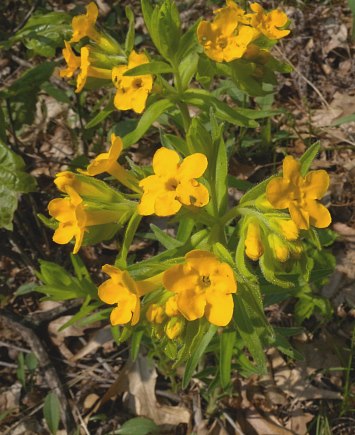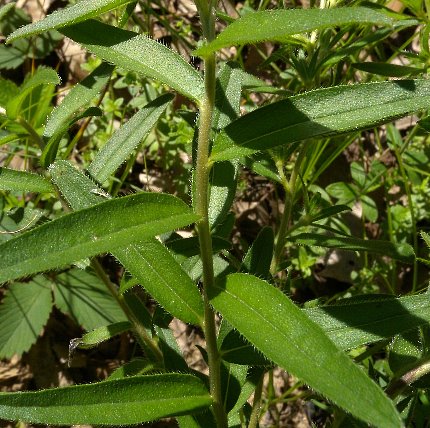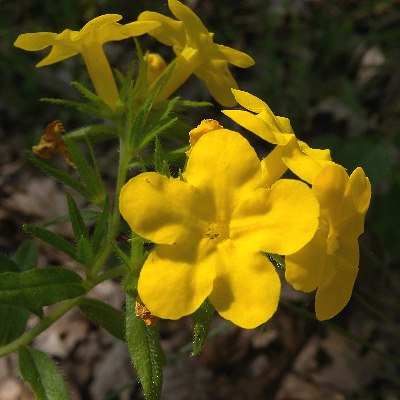
The upper stems terminate in curved racemes of flowers, forming together a flat-headed cluster of flowers. Each flower is about ¾" across, consisting of a yellow to orange-yellow corolla with 5 large rounded lobes, a green hairy calyx with 5 linear-lanceolate teeth, 5 inserted stamens, and a pistil with an inserted style. The tubular corolla has a narrow throat with widely spreading lobes; it is minutely hairy just below the opening of the throat. On some plants, the flowers have long stamens and short styles, while the flowers of other plants have short stamens and long styles. The blooming period occurs from late spring to mid-summer, lasting about 4 weeks. There is no noticeable floral scent. Afterwards, each flower is replaced by 4 shiny white nutlets (or sometimes fewer) that are visible from above. They are distributed by gravity and usually remain near the mother plant. The root system consists of a short stout taproot that is red to reddish purple. This wildflower reproduces by reseeding itself.
Cultivation: The preference is full or partial sun, dry-mesic to dry conditions, and sandy soil. Because the nutlets are difficult to germinate and transplants often fail, this wildflower is not widely available from nurseries, and as a result it is rarely cultivated.

Range & Habitat: The native Hairy Puccoon is occasional in sandy areas of central and northern Illinois, while in the rest of the state it is rare or absent (see Distribution Map). Habitats include open sandy woodlands, sandy savannas, upland sand prairies, sandy hill prairies, sand dunes along Lake Michigan, and sandy embankments along roads and railroads. Occasional disturbance from wildfires and other sources is beneficial if it reduces competition from woody vegetation.
Faunal Associations: The showy flowers are cross-pollinated by such butterflies and skippers as Lycaeides melissa samuelis (Karner Blue) and Poanes hobomok (Hobomok Skipper). The larvae of a long-horned beetle, Hemierana marginata ardens, feed on native Lithospermum spp. (puccoons), probably by boring through the stems or roots. The adults of this beetle mimic fireflies (Lampyridae), probably because of the latter's unpalatability to birds and other predators. The caterpillars of Ethmia longimaculella (Streaked Ethmia Moth) and Ethmia fuscipedella (Gray Ethmia Moth) are known to feed on native puccoons as well. The latter moth is also referred to as Ethmia monticola fuscipedella. White-Tailed Deer occasionally browse on Hairy Puccoon.

Photographic Location: A sandy savanna at the Oak Openings Nature Preserve in NW Ohio, and a stabilized sand dune with scattered oak trees at the Indiana Dunes State Park in NW Indiana.
Comments: The flowers of this wildflower are very showy and brilliantly colored – they can be seen from a considerable distance. Hairy Puccoon is one of three native puccoons (Lithospermum spp.) in Illinois. It can be distinguished from Hoary Puccoon (Lithospermum canescens) by its larger flowers, rough hairs on its foliage, and somewhat greater height. Hoary Puccoon has an abundance of hairs on its foliage, but they have a softer texture. The remaining native species, Fringed Puccoon (Lithospermum incisum), has flowers with fringed lobes, rather than rounded lobes. This latter species also has more narrow leaves. There are some Lithospermum spp. from Eurasia in Illinois, but none of them have the showy yellow to orange-yellow flowers of the native puccoons. Sometimes the scientific name of Hairy Puccoon is spelled Lithospermum carolinense. The specimens of Hairy Puccoon in Illinois (and Ohio) are considered examples of a northern variety of this species, Lithospermum caroliniense croceum. Some authors (e.g., Mohlenbrock, 2014) prefer to treat this variety as a distinct species, Lithospermum croceum, but this viewpoint is not widely accepted at the present time.